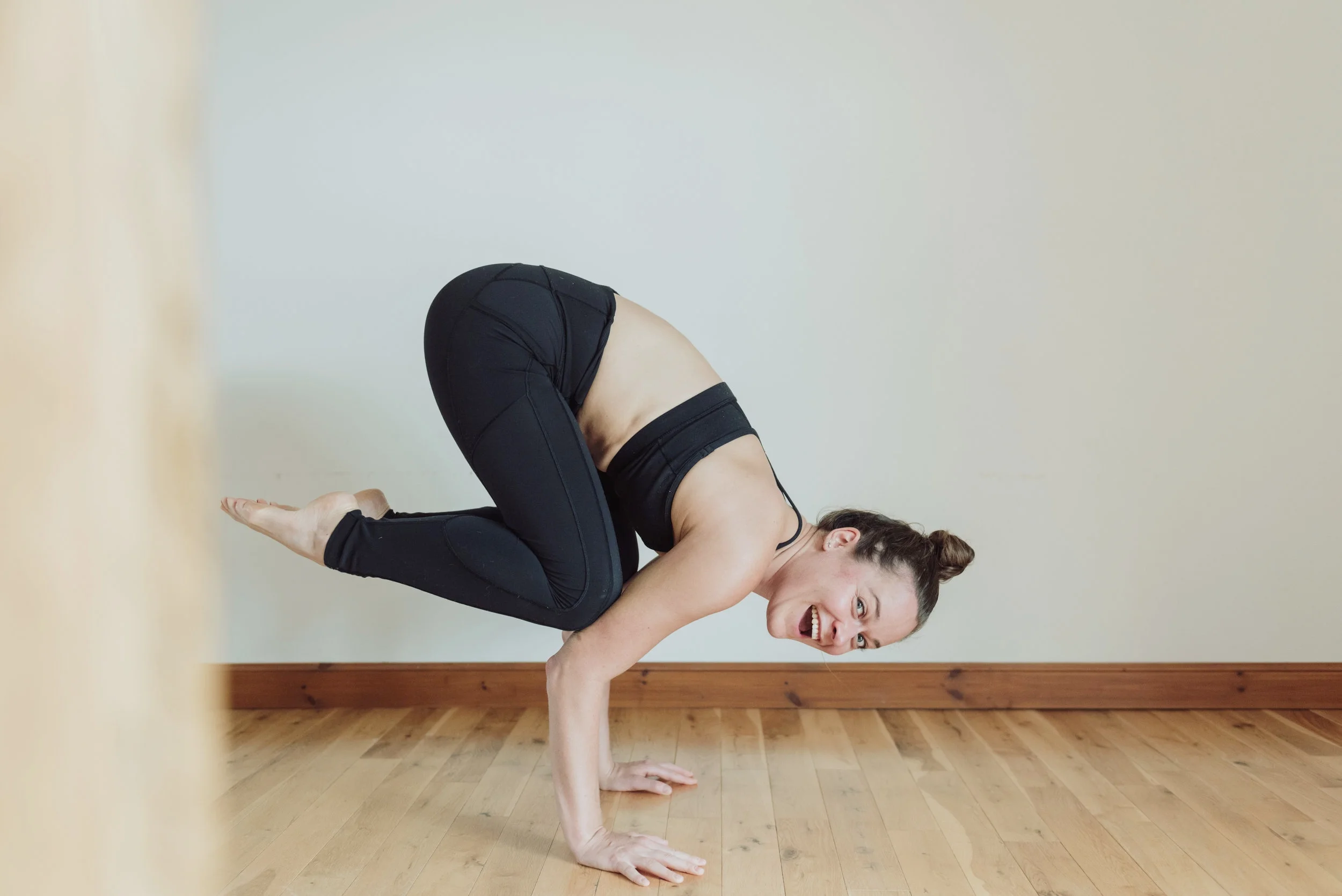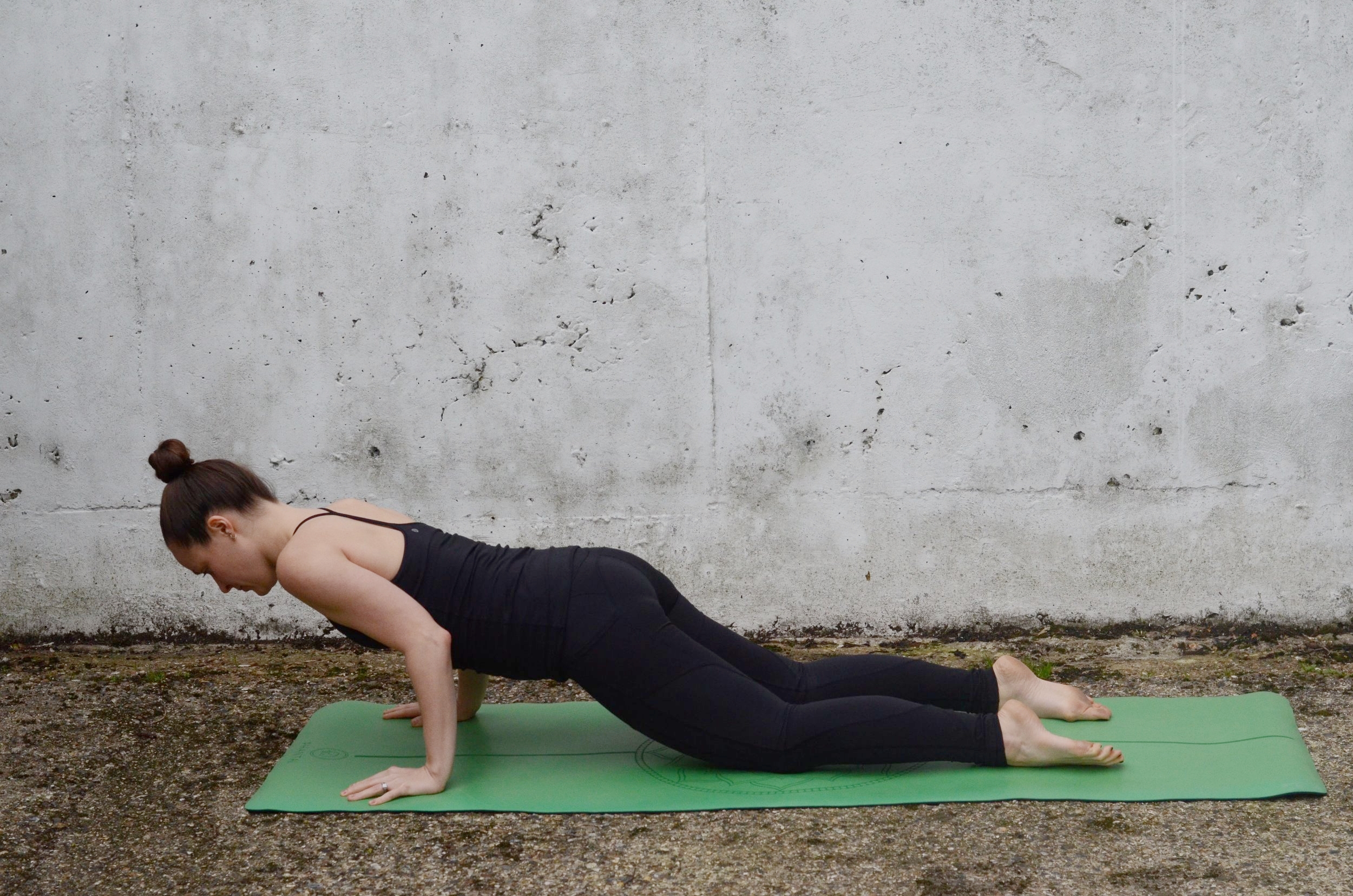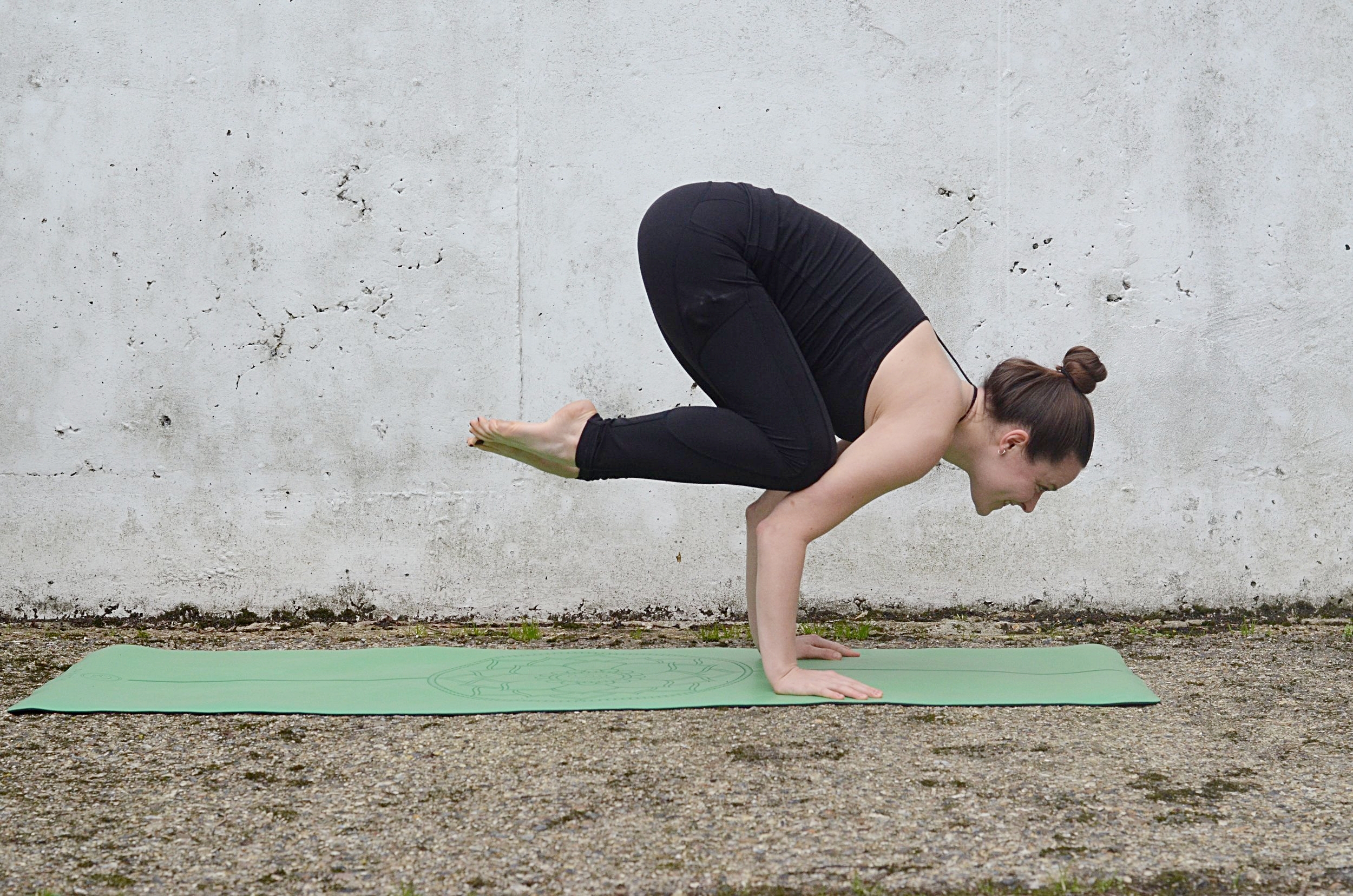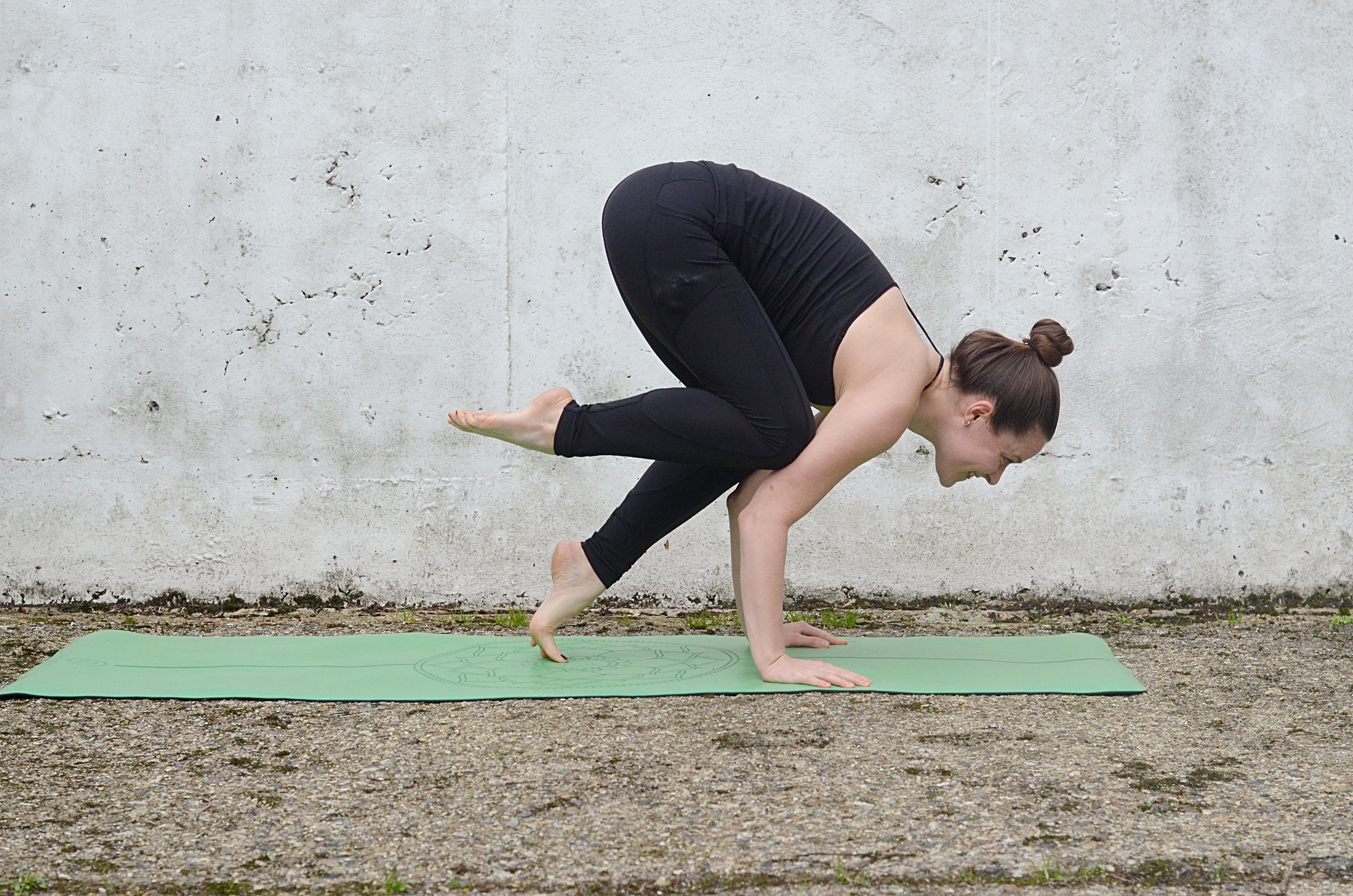
Posture Clinic: Bakasana
Friends, I hear you. That moment in class when the teacher invites everyone to squat and says, ‘And if you have Bakasana (crow pose), take it.’ Meanwhile, you’re sitting there slack-jawed watching everyone around you effortlessly balance their entire body ON THEIR ARMS. (On a side note: yoga is really weird, isn’t it?) Well those people who make it look effortless? It’s because they’ve put in hours and hours of practice. That’s the thing when it comes to the harder yoga poses: there is no big secret, it’s just repetition, repetition, repetition. These are the drills I swear by. READ MORE...
Friends, I hear you. That moment in class when the teacher invites everyone to squat and says, ‘And if you have Bakasana (crow pose), take it.’ Meanwhile, you’re sitting there slack-jawed watching everyone around you effortlessly balance their entire body ON THEIR ARMS. (On a side note: yoga is really weird, isn’t it?)
Well those people who make it look effortless? It’s because they’ve put in hours and hours of practice. That’s the thing when it comes to the harder yoga poses: there is no big secret, it’s just repetition, repetition, repetition.
Bakasana is essentially a squat positioned on top of chaturanga, so work on getting both of those strong and you’re halfway there. These are the drills that really helped me learn the balance, and when I share them in class with students, they too begin to find a bit of air time in the pose.
Make sure you’re warm before you try this pose: a few rounds of sun salutations should do the trick. Good luck, and let me know how you get on!
Ardha navasana
A great pose to isolate and strengthen core. Start lying on your back. Bring your hands into prayer at heart centre, draw in your navel, then lift the chest and legs off the floor a couple of inches, so you feel a sense of ‘hollowing’ in your midsection. Hold for a couple of breaths, release, repeat. Exhale to lower, inhale to lift.
Ardha Navasana
Reclined bakasana
Can't do the pose on your hands yet? Train it on your back! Lie on your mat, draw your knees in towards your chest, then open the knees wide but keep the feet and ankles touching. Curl your shoulders and upper back off the mat, keeping low belly engaged, and reach your arms forwards over your shins. Hold for 5 breaths, rest, and repeat as many times as you have energy for!
Reclined Bakasana
Navasana
Bakasana requires strong hip flexors, so Navasana it is. Come to seated, then with your legs bent, lift them to make a V-shape with your body. Hold onto the backs of the thighs and focus on drawing your navel in and up, and at the same time lift up and out of your lower back. I like to imagine a piece of string is drawing my chest up to the sky. To progress the pose, let go of the thighs while keeping knees bent, working towards extending the legs fully.
Navasana
Chaturanga push-ups
A brilliant way to build upper-body strength, and the foundation of the entire bakasana family. Come onto all fours, then move your knees back an inch. Keeping your body in one straight line, bend your elbows and lower your chest towards the floor before pushing back up again. Make sure you hug the elbows in towards your ribs to engage your triceps. Try three rounds of five reps. Once you feel strong here, try it with the knees lifted, so your hips and shoulders are in line as you lower. If you start to collapse in your lower back (or feel any pain), go back to working with the knees down. This is a hard posture and takes time, so be patient.
Malasana squat
From standing, bring your legs hip-width apart (I actually like to go mat-width, but explore what feels best for your body), turn toes out slightly, then sink your hips down towards the ground. If the heels lift, prop a cushion or rolled up blanket under them for support. Bring the hands to prayer, and use the elbows to ease the inner thighs open while lifting the chest. Allow the lower back to soften towards the ground. Hold for 5-10 breaths.
Malasana Squat
And finally… Bakasana!
From malasana squat, bring the legs and feet together. Turn toes out slightly to open the knees. Place the hands just in front of you, shoulder-width apart, spreading fingers wide. Snuggle the knees into the backs of the arms, so the triceps create a shelf. Next, lift your hips, bend your elbows and start to shift your weight forwards. Play with lifting one foot, then the other, then maybe both.
TOP TIPS
Look forwards, not down, otherwise that’s where you’ll want to go!
Squeeze the big toes together to activate pelvic floor and core
Hug the elbows towards one another to create a strong shelf-like structure
Press through forefinger, fourth finger and thumb
Place blocks under your feet to feel the elevation of the pelvis and actions of the pose, then play with lifting one foot at a time and build strength and trust
Place a cushion in front of your face, just in case!
Why Injury Can Be Our Best Teacher
If you’ve been doing yoga for a while, you’ve probably heard the phrase ‘injury can be our greatest teacher’ at some point. (If you haven't, lucky you.) Hands up, I’ve definitely heard it roll off my tongue on more than one occasion. While certain yoga cliches make my skin crawl, this one, in my humble experience, holds true. READ MORE...
If you’ve been doing yoga for a while, you’ve probably heard the phrase ‘injury can be our greatest teacher’ at some point. (If you haven't, lucky you.) Hands up, I’ve definitely heard it roll off my tongue on more than one occasion. While certain yoga cliches make my skin crawl, this one, in my humble experience, holds true.
Cut to last week however, when a weird lump appeared on the back of my right knee, while I was still recovering from breaking my finger a mere six weeks ago (and losing the nail in the process), and my first reaction was (cue John McEnroe-esque screech): ‘You cannot be serious.’ I mean, I know that I perennially need to learn to slow down, but come on universe, what are you playing at?
The worst part? It popped up (literally) the day before I was due to start module two of my advanced teacher training with Jason Crandell. I managed to make it through the two-hour morning practice on our first day, but come Tuesday I couldn’t fully flex or straighten my leg without feeling like someone was sticking hot pokers in either side of my kneecap. But you didn’t come on here to read about my medical history so long story short, I had to make an emergency trip to hospital and was unable to practice for the rest of the first week.
I'm not going to lie, it sucked not being able to practice for over a week (conflated by the fact I was sitting watching everyone else flow with seeming ease), but it turns out when you have an enforced and unexpected rest period, you have a lot of time to digest and reflect. So that's what I did. Here's what I learned, and I hope it's of some use if you do ever suffer a setback in your practice.
You can’t plan everything – learn to go with the flow
As someone who was essentially a professional planner pre-yoga life (I was the one in charge of making sure we went to press on time at ELLE), let me tell you this: sh*t happens. People miss deadlines. Certain features don’t work no matter how much you rewrite them. Cover stars fall through just before you go to press. Why did I think life beyond journalism would be any different? Injuries happen. Classes get cancelled. Events fall through. As much as it’s great to have ideas and goals, don’t be a slave to them. It will only set you up for disappointment when they don’t work out quite as you’d hoped. Next time something doesn't go quite your way, learn to adapt and go with the flow, and loosen the reins a little. Ask yourself: 'What's the worst that can happen?'
‘You have nothing to prove, and everything to gain’
I'll freely admit these words are Jason's, but they became my mantra for that week I was sitting on the sidelines watching my peers play with various arm balances, inversions, backbends and generally explore and embody what we were learning. Moving my body is my happy place, and has been such an invaluable tool for me when it comes to dealing with anxiety and depression, so to have to sit awkwardly with my leg propped on a couple of bolsters while I watched everyone else flow? That was tough. But as the week wore on and I observed how Jason expertly yet seemingly effortlessly held space for a room of 50 teachers, well, that was an education in itself, and one I wouldn’t have received had I been on the mat. So next time you find yourself building some elaborate narrative while you practice, remember that at the end of the day, the postures don't really matter. We're using the asana as a way to access the mind and learn more about who we are and how we act and react in certain situations, and through that hopefully cultivate some sense of equanimity. Which leads me onto my next point...
Meditation is a really valuable tool
My injury came just as I completed 50 days of continuous meditation (more on that another time) and I don’t think it’s a coincidence that I was able to handle it far more calmly than I would have previously. Yes, I felt vulnerable and frustrated, but those were perfectly normal emotions to experience given the situation. When I found myself getting caught up in negative thoughts I instead reminded myself to focus on the good stuff: the fact I’d been treated so swiftly; that I was still able to observe the classes and participate in everything else; that my peers were so kind and helpful (I was offered a lot of chocolate, tea and bolsters - thank you kind yogis). In short, found I was able to rationalise my thoughts and be far more accepting of the situation as it unfolded. So if you're having a tough time, I'd highly recommend building a meditation practice, even if it's just 3-5 minutes a day of quiet time to check in on what's going on within. I'd highly recommend Headspace or Insight Timer to guide you along the way.
It forces you to explore other areas of your practice
Case in point: meditation. I went deep. Even sitting in sukasana was challenging, so I had to really concentrate on not getting sucked into the vortex of intense sensation that was threatening to overwhelm me. Restorative poses became my best friend. Simple movements such as neck rolls and easy twists were a sweet release. So the next time you have an injury, rather than automatically think, 'Oh, I can't do this', shift your thought process to include, 'Maybe not, but I can do x, y and z.' You'll feel so much richer for it.
It makes you more present
That first practice after a week off? Man, it felt GOOD! I was so present and attentive (and tentative) as I transitioned from pose to pose. Poses like high lunge and warrior one felt so fresh and new, and transitioning to warrior three was a journey in itself (sample inner narrative: 'Oh god, is my knee going to hold, here goes... yes, it does, this is the best thing ever, thanks body!'). Sometimes we can get so caught up in achieving grand postures that we lose sight of the fact that there is so much nuance to explore in the foundational poses.
So as module two draws to a close and I take some time to process everything I've learnt (some unexpectedly) this past fortnight, I don’t think I can sum my experience more beautifully than this famous Reader’s Digest quote, so I’ll just leave it here: ‘Life is what happens to us while we’re busy making other plans.’
Write it down, stick it to your fridge, remind yourself to stay present and embrace the ebb and flow of life.
Blueberry And Banana Pancakes
I have a confession: I'm not the world's biggest breakfast lover. I used to be a porridge fan but, during the week at least, when I'm getting up early to teach, I tend to rely on quick and easy-to-digest smoothies. But when I do have time to luxuriate over brunch, these blueberry and banana pancakes are my go-to. READ MORE...
Start your weekend right with this breakfast
I have a confession: I'm not the world's biggest breakfast lover. I used to be a porridge fan but, during the week at least, when I'm getting up early to teach, I tend to rely on quick and easy-to-digest smoothies with a scoop of protein (kind of essential when you're demoing postures at 7am). But when I do have time to luxuriate over brunch, these blueberry and banana pancakes are my go-to. Made with just eggs and banana, they're gluten-free so don't sit heavily in your stomach and are packed with vitamins and nutrients. This makes about 8-10 ladle-sized pancakes and serves 2-3 depending on how hungry you are (my portions tend to be on the large size).
INGREDIENTS
For the pancakes
4 bananas
2 eggs
Teaspoon baking powder
Teaspoon cinnamon
Butter or coconut oil (for cooking)
1 large punnet blueberries
FOR THE COMPOTE
Frozen blueberries
FOR THE TOPPINGS
Greek or natural yoghurt
Nut butter (I love almond, but go wild)
Honey or maple syrup
Any leftover blueberries
METHOD
First, turn on your oven to 150C, then mash your bananas well in a large mixing bowl. Add the eggs, and beat well to form a smooth(ish) batter. Stir in the baking powder and cinnamon. To make the blueberry compote, add a few handfuls of frozen blueberries to a small pan with a splash of water, bring to the boil, then leave to simmer while you cook the pancakes, adding more water if needed – you want it to be reduced and jam-esque. Meanwhile, grab a large frying pan and melt the butter (or oil, if using), then using a ladle, pour three even-sized circles of mixture into the pan. Sprinkle fresh blueberries onto each one. Fry until the tops of the pancakes are starting to bubble, then flip and cook for a minute or two on the other side. Place the pancakes on a baking tray and pop them in the oven to keep warm while you cook the rest. Repeat until the mixture is finished.
To serve, stack your pancakes, then top with yoghurt, nut butter, honey and any leftover blueberries, and any other toppings you desire (I reckon cacao nibs would be a delicious addition here). Enjoy!
5 Reasons You Should Try Yoga
No one really knows what they’re doing the first time they set foot on a yoga mat. Most of us can’t touch our toes, everyone wobbles when they try tree pose, and the mental effort it takes… well, that’s something that takes years to master. It’s the falling over, picking yourself up, and trying again that matters. READ MORE...
We All Have To Start Somewhere
Let me tell you a story. Sometimes, quite often in fact, I’m lying on the sofa scrolling through Instagram, looking at Insta-yogis doing Insta-inspiring (and quite frankly inconceivable) things with their practice. Sometimes, quite often in fact, I lie there and get increasingly disheartened. More often than not however, namely because I’m quite good at giving my monkey mind a stern talking too when it needs one, I put down my phone and get on my mat because, frankly, no one gets anywhere in life by sitting there thumbing their phone.
Now I’m not saying that every practice I do is an epic 90-minute flow effortlessly linking advanced pose with advanced pose. Nothing like it. But I do make sure I get on my mat 6-7 days a week, even if it’s just to hug a bolster for a while. And that is the key to developing a regular practice: to simply show up and do the work. Some days magic will happen, other days it won’t, and that’s more than OK. What matters is the commitment, discipline and ability to stick at something when the going gets tough.
But I’m getting a bit off track here: the point of this post is that no one really knows what they’re doing the first time they set foot on a yoga mat. Most of us can’t touch our toes, everyone wobbles when they try tree pose, and the mental effort it takes… well, that’s something that takes years (decades even) to master. It’s the falling over, picking yourself up, and trying again (and again, and again), that makes this practice so beautiful. Yoga offers us a sanctuary within which we can safely explore and learn from the stories and inner narratives we all have.
So who cares whether or not you can touch your toes – here are 5 reasons you should try yoga anyway.
It allows you to discover yourself
That first time I stepped on the mat, I just got stuck right in: copying the person in front of me, thinking ‘I’ve got this, I’m so flexible, this yoga stuff is easy…’ Cut to 60 minutes in, just as the teacher was talking us out of savasana, and it was like my brain had melted. I felt so safe, so relaxed, so at ease within myself. I’d never experienced that before. It was that feeling, that sense of coming home, that kept me coming back for more. Your mat becomes a place where you go to comfort yourself, to uncover new layers, to peel back the onion so to speak. It takes you right to your core Self: who you are when you strip all the other stuff (your job, your house, your education, your car, your clothes etc) away. Case in point: by nature I’m really competitive and love being physical, yet I often try too hard and burn out or injury myself as a result. So for me, the practice is about learning to soften and accept that I can’t control everything. Maybe you’re similar, maybe you’re the exact opposite: your mat is the place to uncover, explore and rebalance your tendencies.It gives you a sanctuary
As someone who has struggled with anxiety and depression since my teens, my mat is a real safe haven. If I’m having a bad day, I go get on my mat and will more often than not have a really muddled, confused, erratic practice that reflects my mental state. Sometimes I’ll have a little cry too. Other times, I’m so at one with body and breath it just feels effortless. Your mat is a place to allow all these emotions, the full spectrum of them, bubble up. Honour them and explore them: you’ll feel so much freer for it.It makes you stress less
Yoga and breath are intrinsically linked. The breath helps us find that mind-body connection, encouraging us to move in harmony with it. Slowly but surely, you start to find that when you’re practising, your mind isn’t really thinking about anything else: you’re here, in this moment, just moving and breathing and being in your body and feeling alive. Kapow! You’re BEING PRESENT! Stress has a tendency to rear its ugly head when we’re worrying about the past or the future – in the present moment there is no fear. Yoga – and its focus on being present – helps you build a stress-relieving toolkit that you have with you whenever you need it.It reduces your risk of injury
A lot has been written lately about how dangerous yoga is. Sure, if you a headstand where you’re on the wrong part of your head and you’re not pressing down through your arms, you probably will injure yourself, and you should probably slow down, focus on learning the basics and building strength, then try again once your foundations are solid. But everything in life comes with some level of risk factor, and surely it’s better to move and breath and get into your body than lie on the sofa watching Netflix - I would argue that that is, if anything, more dangerous. But I’m going off on a rant here. Yoga encourages us to be fully present and move mindfully. Through doing so, we build better body awareness, thus minimising the risk of injury. Does a pose feel uncomfortable in your body? Then back off or come out of it, and ask your teacher for an alternative. Moreover, your muscles are only as strong as they are flexible, so it’s important to balance out whatever other training you’re doing (running, cycling, weight training, CrossFit) with yoga to improve mobility. You’ll feel so much stronger for it. Yoga teaches you to be aware of and compassionate towards your body. If something hurts, don’t do it - seek an alternative pose. Which leads me onto my final point...It teaches you to listen to – and love – your body
The great thing about yoga is you can modify or intensify your practice as much as you need to on any given day. Feeling tired? Let yourself rest in child’s pose as much as you need to. Feeling like you need to burn off excess energy? Do those extra chaturangas and handstand hops. Old injury playing up? Ask your teacher how you can modify and feel empowered that you’re looking after your body. Self care is key. I’ve honestly - despite all the tiny, toned, Lycra-clad yogis I see daily on social media - have never felt better about my body than now, age 34, 10 years into my yoga practice. Practising yoga makes me feel strong and able, which is empowering, and it’s also encouraged me to soften and accept what is, and treat myself with compassion and kindness, and I think we could all do with a little more of that, right?














